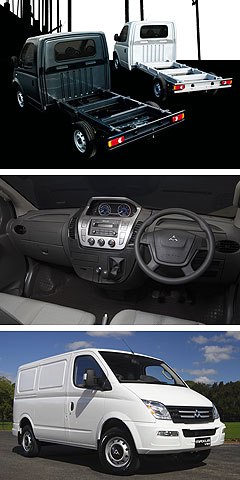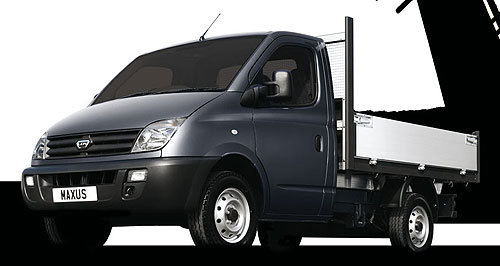Future models - Maxus - V80 - Cab ChassisFirst drive: Maxus light truck set to join van rangeHail the cab: Maxus will offer extra versatility for its V80 light commercial range in Australia with the addition of a cab-chassis variant, enabling numerous possible uses from tipper trucks to motor homes. Chinese-built Maxus V80 van set to spawn cab-chassis variant for Australia26 Apr 2012 By RON HAMMERTON in BEIJING CHINESE vehicle giant Shanghai Automotive Industry Corporation (SAIC) is already planning to add a Maxus cab-chassis light truck to the range of Maxus V80 vans that is set to debut in seven styles in Australia and New Zealand later this year. The truck version is due to start rolling down the Maxus production line at Wuxi, north-west of Shanghai, in July for the Chinese market, and is expected to join the vans in Aussie showrooms after the Maxus one-box line-up arrives in a 25-dealership network in October. The company also revealed today that it has a smaller people-mover – codenamed SV71 – under development from the ground up at its research and development centre in Shanghai, with a launch target date of 2014 in China. Pricing and full specifications of the Maxus V80 range are still being developed by importer WMC Group, but early indications are that the British-engineered, diesel-powered V80 will be positioned between the smaller Hyundai iLoad/iMax – Australia's current van market champion – and the similar-sized Ford Transit and Volkswagen Vito vans. Powered by a 100kW/330Nm 2.5-litre four-cylinder turbo diesel engine built in China by SAIC using Italian VM Motori technology, the Euro 4 V80 will come in two wheelbase lengths, two roof heights and a choice of cargo or passenger configurations. The mini-bus versions are likely to come in standard and deluxe trim with seating for between nine and 15 passengers, although the exact seating layouts are yet to be confirmed. A five-speed manual gearbox will be standard, but an automatic transmission alternative using an Aisin transaxle is under development for Australia and New Zealand. The Maxus range went on sale in China last year and is now being exported to a range of countries, including South Africa, Malaysia and Chile. The range is being built in a factory that was bought lock, stock and barrel from cash-strapped British Leyland descendant LDV in 2009, with all the machinery shipped from Birmingham to Wuxi, an industrial city of about six million people. The factory was up and running in just 18 months, with the Chinese market launch held mid-2011. So far, only 5000 of the vans have been produced – a drop in the ocean in the 18-million vehicle market in China – and most of those have gone to export.  From top: Maxus V80 Cab Chassis, V80 interior, V80 Van. From top: Maxus V80 Cab Chassis, V80 interior, V80 Van.However, the plant has been designed to churn out 150,000 vehicles a year on three shifts, and considering SAIC's record as China's biggest and most aggressive vehicle producer, with a 2011 production figure of four million vehicles, nobody would doubt the company's ability to achieve its target and then some. SAIC Commercial Vehicle plant manager Wu Hongyi told Australian journalists who visited the factory this week that the production systems used to build the V80 range were the same as those used in SAIC’s joint venture plants with Volkswagen and General Motors in China. In fact, before leading the project to transplant the LDV factory to China and commence production of the V80, Mr Wu was a senior executive at the GM Shanghai factory that builds the Chevrolet Cruze – one of the top-selling vehicles in China today. “The production for export and Chinese markets at the Maxus plant is the same for domestic and export vehicles,” he said. “It is all done to passenger-vehicle quality standards.” Body panel gaps are said to be designed to a 2mm standard – high by even luxury car levels. Mr Wu said that despite SAIC's massive presence in the passenger vehicle scene in China, it was a relatively small player in the China commercial vehicle market. Maxus is one way SAIC is rectifying that, he said. Among SAIC's current list of joint venture partners is Iveco, with whom it builds trucks and buses for domestic sales under the Iveco brand. SAIC has been expanding its portfolio of own-brand vehicles, including the one-time British brand MG and Roewe, both of which it acquired in 2005 through its merger partner Nanjing Automobile. The Maxus van was originally designed and built for the European market by LDV in the UK, which can trace its origins back more than 100 years to a steam-powered Leyland truck. The LDV Maxus LD100 was launched in the UK in 2005, and despite accolades, could not save LDV from financial peril. Within four years, the company had been sold in a fire sale to SAIC which not only secured the near-new Maxus van range but all the factory equipment to boot. The Maxus van is a front-drive monocoque design, with MacPherson strut front suspension and a basic leaf-sprung rear setup. SAIC says the suspension was tuned at Britain's Motor Industry Research Association (MIRA) test facility in the UK, and marked one of the main changes from the original British production model. They said this was necessary because of the need to cope with a huge variety of road surfaces in China and the proposed export markets, including Australia. Rear barn doors and a large sliding side door are standard on all models, along with dual-zone air-conditioning in the minibus models. For Australia, all Maxus V80s will be equipped with four-wheel disc brakes, ABS, EBD and two front airbags. ESC is not yet available, but WMC has requested it to be developed as soon as possible. Short-wheelbase models sit on a 3100mm wheelbase, while the stretched versions take that to 3850mm. Overall lengths range from 4950mm to 5700mm. The cab-chassis version of the V80 is built to about the same dimensions as the long-wheelbase van, but with a ladder-chassis that extends behind the single cab that, unlike the vans that have two front bucket seats, can sit three people across a bench seat. For China at least, the cab-chassis will come in two styles – ‘bare’, ready for a coachbuilder to apply the finishing touches, or with a simple drop-side tray. As the cab-chassis is still at the pre-production stage, GoAuto did not see one in the flesh at the factory, but we were handed the keys to a 15-seat long-wheelbase minibus for a lap around the factory access roads. Sitting relatively high off the ground with a floor to match, the V80 takes a little effort to scale the driver's seat, which is eight-way adjustable. Some taller drivers had the seat all the way back to the end of its slides to get comfortable behind the steering wheel, which is fixed in position and rather flat, like a bus tiller. The instruments are mounted in the middle of the dash to suit both left-hand drive and right-hand drive markets, but some drivers might fund it disconcerting to have the speedometer sitting off to the left, above the dash-mounted gear shift lever. The familiar diesel chatter is about par for the course in this type of vehicle, and all the controls – clutch, gear selection and steering – are light to the touch. Acceleration is surprisingly sprightly, given that the figures given by Maxus show an official zero-to-100km/h acceleration time of a tardy 23.6 seconds. However, our short burst suggests the V80 is about on par with many of the current vans in Australia, with passable road manners. The engineers at MIRA achieved their goal of devising a suspension with almost car-like ride but truck-like utility. The question of build quality will not be answered until the final production vehicle arrives in Australia in numbers, but the paint quality and fit and finish appeared acceptable, even pleasing. Some of the upper-spec models had hand-sprayed bumpers (the standard models have utilitarian black plastic) that showed a little unevenness, but the new paint shop – one of the few parts of the manufacturing process not shipped from the UK – meets expectations for the remainder of the vehicle. As GoAuto has reported, the Maxus range will be sold through a separate retail network to WMC's other Chinese offerings, Higer buses and JAC trucks, with the latter also preparing to join the van wars in Australia from next year. WMC says it hopes to sell about 100 Maxus vans a month from October.  Read more24th of April 2012  Beijing show: Maxus locked in for October launchSAIC’s Chinese-built vans on countdown for Australian debut in 20 dealershipsAll future models Alfa Romeo Alfa Romeo Abarth Abarth Audi Audi Aston Martin Aston Martin BMW BMW Bentley Bentley Chrysler Chrysler Chevrolet Chevrolet Dodge Dodge Citroen Citroen Ferrari Ferrari DS DS Ford Ford Fiat Fiat FPV FPV Foton Foton Haval Haval Great Wall Great Wall Honda Honda Holden Holden Hyundai Hyundai HSV HSV Isuzu Isuzu Infiniti Infiniti Jeep Jeep Jaguar Jaguar Lamborghini Lamborghini Kia Kia Lexus Lexus Land Rover Land Rover Mazda Mazda Maserati Maserati Mercedes-Benz Mercedes-Benz McLaren McLaren Mini Mini Nissan Nissan Mitsubishi Mitsubishi Peugeot Peugeot Opel Opel Proton Proton Porsche Porsche Renault Renault Ram Ram Saab Saab Rolls-Royce Rolls-Royce Smart Smart Skoda Skoda Subaru Subaru SsangYong SsangYong Tesla Tesla Suzuki Suzuki Toyota Toyota Volvo VolvoMotor industry news |
Click to shareMaxus modelsAll future models Alfa Romeo Alfa Romeo Abarth Abarth Audi Audi Aston Martin Aston Martin BMW BMW Bentley Bentley Chrysler Chrysler Chevrolet Chevrolet Dodge Dodge Citroen Citroen Ferrari Ferrari DS DS Ford Ford Fiat Fiat FPV FPV Foton Foton Haval Haval Great Wall Great Wall Honda Honda Holden Holden Hyundai Hyundai HSV HSV Isuzu Isuzu Infiniti Infiniti Jeep Jeep Jaguar Jaguar Lamborghini Lamborghini Kia Kia Lexus Lexus Land Rover Land Rover Mazda Mazda Maserati Maserati Mercedes-Benz Mercedes-Benz McLaren McLaren Mini Mini Nissan Nissan Mitsubishi Mitsubishi Peugeot Peugeot Opel Opel Proton Proton Porsche Porsche Renault Renault Ram Ram Saab Saab Rolls-Royce Rolls-Royce Smart Smart Skoda Skoda Subaru Subaru SsangYong SsangYong Tesla Tesla Suzuki Suzuki Toyota Toyota Volvo VolvoMotor industry news |
















Facebook Twitter Instagram